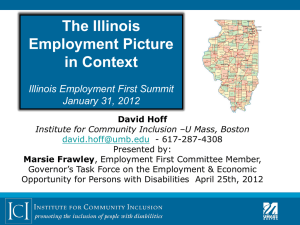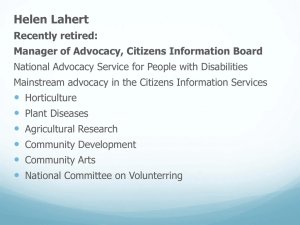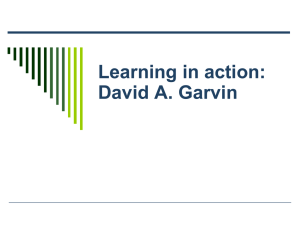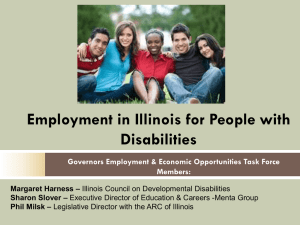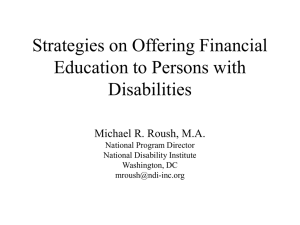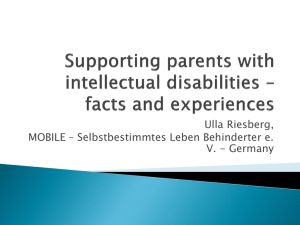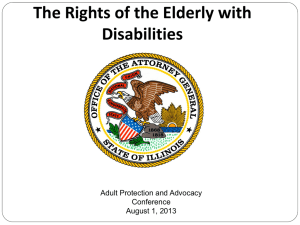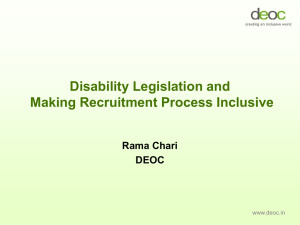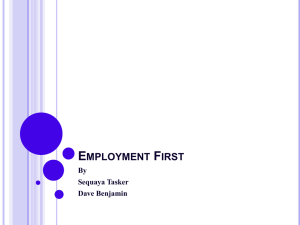Olmstead Cases - Supportive Housing Providers Association
advertisement
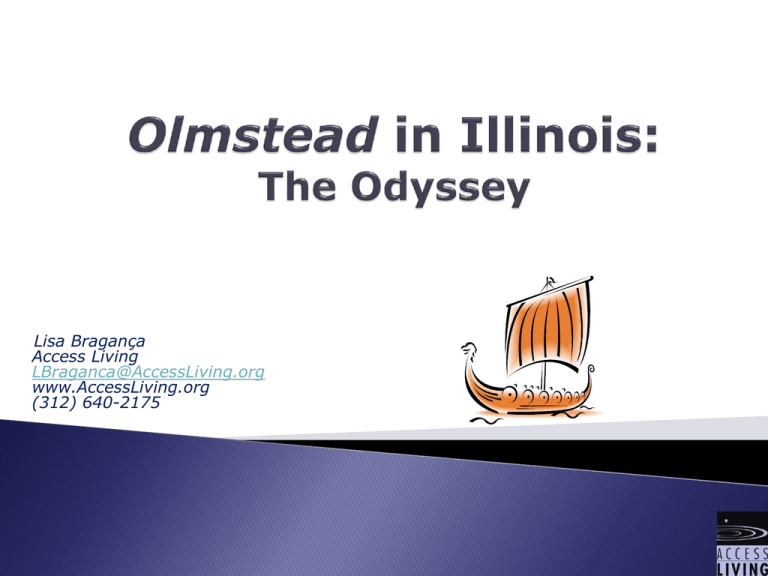
Lisa Bragança Access Living LBraganca@AccessLiving.org www.AccessLiving.org (312) 640-2175 1971 First Center for Independent Living established by people with disabilities for people with disabilities de-medicalization de-institutionalization Individual and Systems Advocacy Information and Referral Peer Support Independent Living Skills Training Independent Living Staff work to: End the unnecessary institutionalization of people with disabilities Improve/expand services and programs that allow people with disabilities to live independently. Americans with Disabilities Act (ADA) The ADA prohibits discrimination on the basis of disability in employment, state and local government, public accommodations, commercial facilities, transportation, and telecommunications. ADA Title II regulations require public entities to: “administer services, programs, and activities in the most integrated setting appropriate to the needs of qualified individuals with disabilities.” Most integrated setting is one that “enables individuals with disabilities to interact with nondisabled persons to the fullest extent possible . . . .” 28 C.F.R. § 35.130(d) and 28 C.F.R. Pt. 35, App. A (2010) (addressing § 35.130). ADA prohibits the unjustified segregation of individuals with disabilities. Public entities are required to provide community-based services to persons with disabilities when: ◦ such services are appropriate; ◦ the affected persons do not oppose communitybased treatment; and ◦ community-based services can be reasonably accommodated, taking into account the resources available to the entity and the needs of others who are receiving disability services from the entity. Olmstead v. L.C. “[I]nstitutional placement of persons who can handle and benefit from community settings perpetuates unwarranted assumptions that persons so isolated are incapable or unworthy of participating in community life.” “[C]onfinement in an institution severely diminishes the everyday life activities of individuals, including family relations, social contacts, work options, economic independence, educational advancement, and cultural enrichment.” From 1999 through 2005, no meaningful response from State officials Disability advocates formulated a plan to file lawsuits to enforce Olmstead Three lawsuits required because different administrative agencies oversee different populations of people with disabilities living in different types of institutions Lawsuits brought by coalition: - Access Living - Equip for Equality - ACLU of Illinois - Pro bono counsel: SNR Denton Kirkland & Ellis State of Illinois has settled all three cases by entering into “Consent Decrees” “Consent Decrees” are negotiated settlements that must be approved by the Court after a “fairness hearing” Consent Decrees have been approved by the Court after fairness hearings Williams v. Quinn (“Williams”) - Approximately 4,300 Medicaid-eligible adults throughout Illinois who: - have serious mental illness - live in IMDs (Institutes of Mental Disease) and - with appropriate supports and services can live in the community Williams case - Independent Evaluations - Person-Centered Planning - Expanded service array (Medicaid and non-Medicaid services) - Savings for State of Illinois Williams case ◦ Over the next five years all IMD residents who wish to live in the community and who can do so with appropriate services can move into the community ◦ Benchmarks By June 30, 2012, 256 IMD residents moved into the community (first year) 640 IMD residents by the second year 40% of IMD residents by the third year 70% of IMD residents by the fourth year 100% of IMD residents by the fifth year ◦ Provide funding for rental assistance and transition costs Ligas v. Maram (“Ligas”) - Nearly 6,000 adults throughout Illinois - with developmental disabilities - who live in large private ICF-DDs (9 or more residents) or who live at home and are “at risk of institutionalization” - who have expressed a desire to move out of the ICF-DD into a more integrated community placement Colbert v. Quinn (“Colbert”) - Approximately 17,000 Medicaid-eligible adults in Cook County who: - have a physical disability or serious mental illness - live in nursing facilities - with appropriate supports and services can live in the community Colbert case ◦ Meet measurable benchmarks for transitioning people into the community During the first 30 months, 1,100 people who wish to live in the community and who can do so with appropriate services will be transitioned out of nursing facilities During the first 18 months, have independent professionals conduct assessments of at least 2,000 class members Colbert case $10 million in housing assistance along with funds for transition costs and home modifications ◦ Develop community capacity ◦ Develop accessible, affordable housing stock ◦ Develop a cost neutral plan based upon phase 1 results Williams case With limited exceptions, Permanent Supportive Housing (“PSH”) is considered the most integrated setting for class members. Integrated permanent housing with tenancy rights, linked with flexible community-based services that are available to consumers when they need them, but are not mandated as a condition of tenancy. Williams case Year 1 (ending June 30, 2012) Secure 256 units of PSH Year 2 (ending June 30, 2013) Secure additional 384 units of PSH for a total of 640 units. Permanent Supportive Housing can be: - scattered site – preferred - site-based - enhanced property management - master leasing Capital Funding sources: - Low Income Housing Tax Credit (LIHTC) - Building Illinois Bond Fund $130 million - Illinois Affordable Housing Trust Fund - Community Development Block Grant - HOME Investment Partnership Rental Assistance: Bridge Subsidy – expedited basis for Williams $10 million funding for Colbert Transition and Home Modification Funding Accessliving.org Equipforequality.org ACLU-il.org
